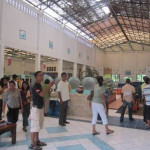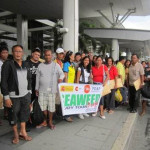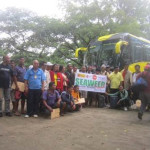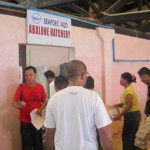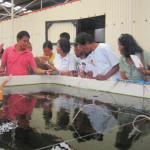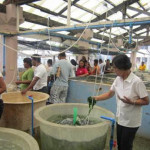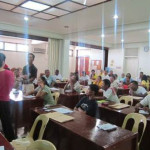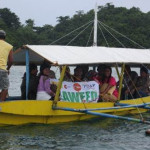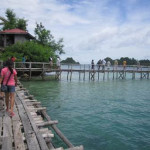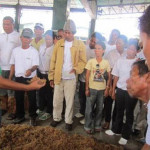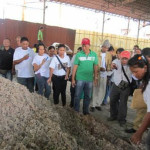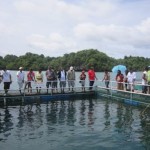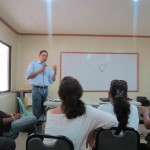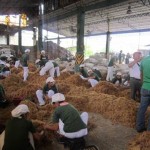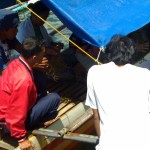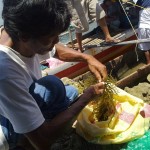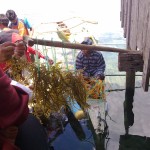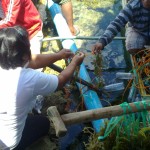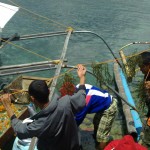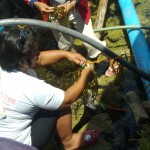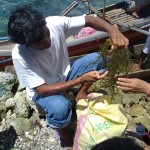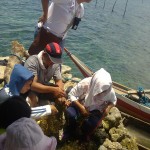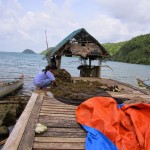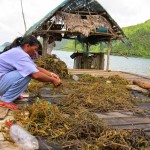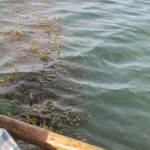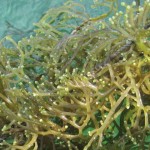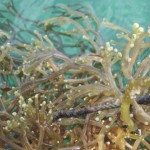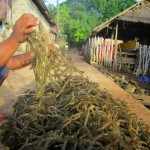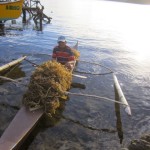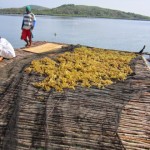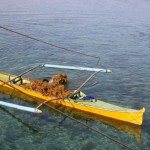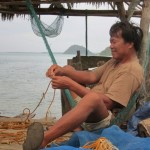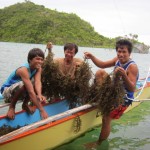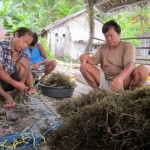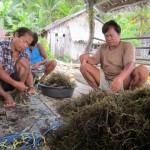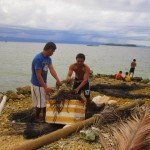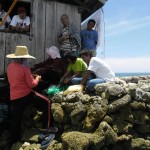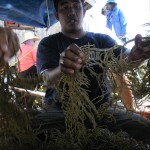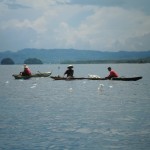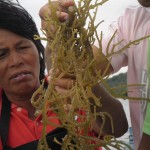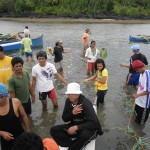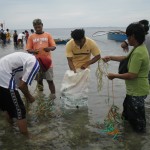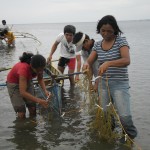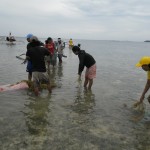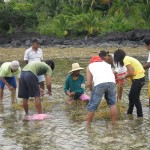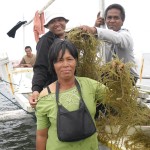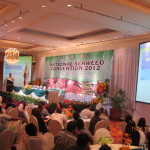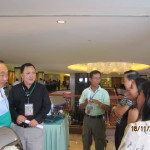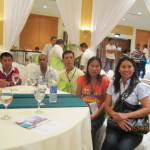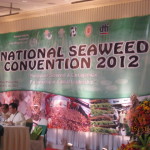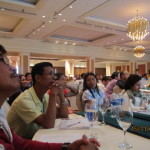Author Archives: pdap
End-of-Project Report share
Improvement of seaweeds production and farming technology
Prior to the implementation of project activities, community meetings in Barangays Salvacion and Binocyahan were conducted to validate the specific interventions that will help revive the livelihood of households through seaweeds farming. Project interventions were: a) coaching and mentoring on seaweeds farming technology; b) setting up of savings mobilization program; and, c) conduct of capacity building activities on organizational development to strengthen the farmer organizations.
Project implementation started in March 2014 in coordination with the local governments of Basey and Marabut, Western Samar through their respective Office of the Municipal Agriculture (OMAg). Technical trainings and on-site coaching and mentoring were conducted from March 2014 until the end of the project. Farmer beneficiaries were introduced to new seaweed farming technology specifically on proper site identification, mooring blocks construction, farm installation and cultivar lines preparation. Farmer beneficiaries were also introduced to the “ambian” or “spider-web” planting method which is different from the mono-line method being practiced in Eastern Samar. Pest and disease control as well as disaster risk reduction measures especially during typhoons were imparted to the farmer beneficiaries.
Materials preparation and frame installation were done from June to July 2014. The project provided initial material inputs (i.e. ropes, nylon, floaters, softies, cement and seedlings) while the farmers took responsibility for the labor as part of their counterpart.
In August 2014, a total of 81 farmers (i.e. 43 in Brgy. Salvacion and 38 in Brgy. Binocyahan) started to plant seaweeds. Farmers in Brgy. Binocyahan were able to harvest in October 2014. However, farmers in Brgy. Salvacion were affected by the low pressure area (LPA) which hit the area in September 2014. Recovery efforts were done and harvest was expected in December 2014; however, they were once again affected by Typhoon Ruby on the 1st week of December. Because of this, most of the farmers in Brgy. Salvacion lost interest in seaweeds farming. In the 2nd quarter of 2015, seaweeds farming in Brgy. Salvacion was stopped and focused on fish processing. Some farmers in Brgy. Binocyahan also decided to stop planting seaweeds as they preferred to do skilled labor and fishing. Only 15 out of the 38 farmers in Brgy. Binocyahan continued planting seaweeds. Seventeen (17) farmers from Brgy. Amantillo were added as project beneficiaries. Unused farm materials in Brgy. Salvacion were transferred to Brgy. Amantillo. One (1) plantation frame was also installed in Brgy. Amantillo. Additional seedlings were distributed to farmers of both barangays in the last week of September 2015.
Total gross income generated from the sales of raw dried seaweeds (RDS) and fresh seaweeds of the 15 farmers in Brgy. Binocyahan since their 1st harvest in October 2014 until December 2015 stood at Php53,353. Average monthly income per farmer amounted to Php3,557 or an additional Php237 to each farmer’s income prior to seaweeds farming. In Brgy. Amantillo, no income was generated yet since the farmers started planting seaweeds only in the 4th quarter of 2015.
A seaweed nursery was also established in Brgy. Binocyahan. It generated a total income of Php4,500 from the sale of 100kgs. of seedlings between October 2014 and March 2015 and 300kgs. of seedlings in the last quarter of 2015.
As of December 2015, 800kgs of crops (500kgs in Brgy. Binocyahan and 300kgs in Brgy. Amantillo) have yet to be harvested. Needless to say, the crops will be harvested after project completion with provisions for continuity of seaweed farming.
In August 2015, local buying was established in Brgy. Malobago. The local buyer (i.e. private individual) buys the consolidated produce of the POs as well as the produce of the farmers in the municipalities of Lawaan, Balanggiga and Giporlos, Eastern Samar.
The establishment of local buying has rekindled the interest of some farmers to plant again and those who continued were encouraged to consolidate their produce considering the distances of the barangays to the local buyer. Farmers at the barangay level collected the RDS from each member which were weighed individually and repacked in sacks prior to delivery. Transactions were made through exchanges of Short Messaging Service (SMS) between the buyer and the assigned PO members. The produce were then delivered by the member in-charge.
Weekly price monitoring were conducted. TBK (a seaweed processing company in Tacloban) sent price information (including adjustments) and other advisories through SMS.
Local seaweeds production and market networks were established in Marabut and nearby municipalities of Eastern Samar where seaweed farming was present. It was intended to guide farmers where to get seaweed cultivars and where to sell their produce (See Annex 3). With the presence of a local buyer and establishment of market networks, it was expected that farmers will continue to plant seaweeds and expand their farms even after the completion of the project.
Promoting farmers access to credit through self-help approach
Savings mobilization was implemented to provide farmer beneficiaries access to credit for their immediate expenses. A total of 124 PO members from the three (3) barangays (i.e. 34 in Brgy. Binocyahan, 18 in Brgy. Salvacion and 72 in Brgy. Amantillo) participated with Php20.00 weekly savings per member. Members in Brgy. Binocyahan started as early as July 2014; those in Brgys. Salvacion and Amantillo started in January 2015 and October 2014, respectively. As of December 2015, total savings in the three (3) barangays stood at Php121,183 (i.e. Binocyahan-Php56,364; Salvacion-Php15,703; Amantillo-Php49,116).
Members availed of loans ranging from Php500 to Php2,000 with 1-2% weekly interest which they used for education, medical and household consumption expenses. Some were able to pay-off their debts to micro-finance institutions. Given its benefits, PO members were committed to continue their respective savings mobilization schemes even after the end of the project. It is noteworthy that as of to date, PO members have stopped borrowing money from micro-finance institutions.
Mobilization of functional Peoples Organizations (POs)
Three (3) People’s Organizations (POs) were organized; namely, Jinamoc Island Seaweeds Farmers Association (JISFA), in Brgy. Salvacion, Women Integrated Seaweeds Farmers Association (WISFA) in Brgy. Binocyahan and Brgy. Amantillo Women’s Association (BAWA) in Brgy. Amantillo. Among the three (3) POs, only BAWA had secured registration from the Department of Labor and Employment (DOLE). JISFA was reprocessing its application based on DOLE’s recommendations on the amendments of some of its documents while WISFA was waiting for the approval of its registration.
Total number of members of the three (3) POs reached 152; 14% were men while 86% were women (See Table 3). Out of the 152 members, 124 were actively participating in the savings mobilization program.
Operationalization of fish processing centers in Brgy Salvacion, Basey and Brgy Amantillo Marabut.
The project saw the need to provide additional source of income to the beneficiaries as seaweeds farming is exposed to various risk factors (i.e. typhoons, diseases, etc.) which affects farmers’ production and income both in terms of consistency and adequacy.
In July 2015, fish processing was identified as a viable enterprise to augment farmers’ income from seaweeds farming since other donor agencies have provided the municipalities of Basey and Marabut with fish cages. In partnership with and funding support from the Soroptimist International, 60 women members of two of the three PO partners (i.e. 20 in JISFA and 40 in BAWA) were trained and given technical assistance in fish processing. Hands-on trainings were conducted on July 13–17, 2015 and July 20–24, 2015 in Brgy. Salvacion and Brgy. Amantillo, respectively. Systems such as committees, product pricing and sharing schemes were installed in both POs. Financial systems such as record keeping and the use of accounting forms were also introduced.
In September 2015, the construction of two (2) fish processing centers in Brgys. Salvacion and Amantillo were completed and now operational. The facilities and other fish processing equipment were turned-over to the POs in December 2015.
While the basic operating and financial systems of both POs were in place, they need to be developed further. Members’ enterprise capacities should be enhanced to sustain the gains of the project. There is also a need to develop and expand the market so they can earn more. However, these can only be done beyond the project timeline.
An additional working capital for both POs is also necessary to help sustain their respective enterprises. The additional working capital may come from the reinvestments of POs’ income from operations and outside funding.
EXECUTIVE SUMMARY share
In 2014, the Partnership for Development Assistance in the Philippines Inc. (PDAP) was tapped by the Overseas Missionary Fellowship (OMF) International, Philippines through its Serving Affected Families Effectively (SAFE) program to implement the livelihood component of its then on-going rehabilitation projects in the municipality of Marabut, Western Samar. With funding support from the OMF-SAFE, PDAP implemented the Enhancing Coastal Communities’ Recovery and Resiliency from Disaster through Seaweeds Farming Project in February 2015 to January 2016.
The project sought to revive the seaweeds industry in Marabut, Western Samar by increasing production through a) provision of production inputs; b) provision of technical assistance through direct coaching and mentoring and on-site technical advisories; and, c) expansion of production areas to cover the four (4) barangays (i.e. Logero, Binocyahan, Pinalangga and Amambucale) in the municipality of Marabut that passed the water sampling and where OMF-SAFE has an on-going rehabilitation project.
The initial target beneficiaries of the project were the 241 household members who were then benefitting from the OMF-SAFE housing project in the four (4) barangays in Marabut. However, only 114 signified their interests to participate and only 73 of those who signified interests participated in the 1st and 2nd batch of seaweeds planting. Due to the minimal participation of the targeted beneficiaries, PDAP in consultation with OMF-SAFE decided to expand the beneficiaries to other barangays that are not covered by OMF-SAFE’s housing project. Interested farmers from Brgys. Malobago and Ferreras were accepted. Farmers in Brgy. Ferreras eventually decided not to participate choosing to focus on an ongoing project in their barangay. Some farmers in other barangays also decided to stop planting due to the presence of sea turtles while others were discouraged as their crops were damaged by strong currents brought by typhoons. At the end of project implementation, only 70 farmer-beneficiaries in the five (5) barangays (i.e. Logero, Binocyahan, Pinalangga, Amambucale and Malobago) remained active in seaweeds farming.
Farmer-beneficiaries were provided with farm implements and technical assistance on seaweeds farming. A total of 17 frames were installed in the five (5) barangays and two (2) seaweed nurseries were established in Brgys. Logero and Amambucale. Eleven (11) seaweed dryers from another PDAP project under Tabang Visayas were also installed in Brgys. Malobago and Logero.
Local buying in Brgy. Malobago was established. Local seaweeds production and market networks were also established in Marabut and nearby municipalities of Eastern Samar where seaweeds farming was present. Farmer-beneficiaries were also given information on the business side of seaweeds farming.
Savings mobilization scheme was introduced to the People’s Organization (PO) members. POs were also mobilized and assisted in securing their registration with the Department of Labor and Employment (DOLE).
The project resulted in: a) improved seaweeds farming technology and production; b) improved access of farmers to credit through self-help approach; and, c) mobilized functional POs in the five (5) barangays.
Jose Pangaronon of PSPFA share
 “I am Jose Panganoron Jr.,married with two children and residing at Brgy Manyayay, Lainga, Surigao del Sur. I am currently the president of the Pocto Seaweeds Planters and Farmers Association (PSPFA) with a total membership of 56 members. We are a growing organization receiving assistance from AECID, CODESPA and PDAP in their efforts to uplift individual lives through seaweeds farming. Among the projects implemented was the establishment of seaweeds nursery with a working area and solar dryer. However, these facilities were destroyed by the typhoon leaving only the working area which we are using until now to dry our seaweeds to ensure high quality of our products.
“I am Jose Panganoron Jr.,married with two children and residing at Brgy Manyayay, Lainga, Surigao del Sur. I am currently the president of the Pocto Seaweeds Planters and Farmers Association (PSPFA) with a total membership of 56 members. We are a growing organization receiving assistance from AECID, CODESPA and PDAP in their efforts to uplift individual lives through seaweeds farming. Among the projects implemented was the establishment of seaweeds nursery with a working area and solar dryer. However, these facilities were destroyed by the typhoon leaving only the working area which we are using until now to dry our seaweeds to ensure high quality of our products.
The PDAP project implementers have also imparted trainings aimed at improving the capacities of our organization concerning management, basic accounting and bookkeeping for our internal control systems. As of now, we already have a bank account and we continued to do our part as members by setting-up a capital build-up fund and paying our monthly dues. We have even agreed to volunteer ourselves to use our own money for fares and transportation expenses so the organizational funds could solely be used for other purposes like supplies and other needs.
We are so grateful with PDAP for helping us and we wish that more communities will benefit from their assistance.”
Ronalyn Madrazo of RCBRMPO share
 “I am Ronalyn Madrazo, married with four children and residing at Brgy Rizal, Barobo, Surigao del Sur. I am the current president of the peoples organization called the Rizal Community-Based Resource Management Peoples Organization (RCBRMPO).
“I am Ronalyn Madrazo, married with four children and residing at Brgy Rizal, Barobo, Surigao del Sur. I am the current president of the peoples organization called the Rizal Community-Based Resource Management Peoples Organization (RCBRMPO).
My husband and I started planting seaweeds in 2008 with a capital of PhP2,000.00. After 15 days, we observed that the “ice-ice” (epiphytes) infected our seaweeds. To remedy the situation, we harvested our seaweeds pre-maturely and sold it to local traders. We lost our capital. The next cropping season, we spent another PhP2,000.00 for seaweeds and experienced the same failure. We tried again and that same year, we lost
PhP20,000 capital that made us decide to stop farming seaweeds. We were discouraged by our failures.
In 2011, the PDAP coordinators arrived in our barangay. They conducted a 3-day Seaweeds Training in Lianga, Surigao del Sur from September 19-21, 2011. In that training, I learned a lot about the modern ways of seaweeds farming. Compared to our traditional farming practices where we installed 200-meter cultivar lines, it is wise to divide the cultivar lines into four at 50 meters in length for easy monitoring, maintenance and cleaning of seaweed cultivars. I also learned that the proper distance of planting seaweed propagules is around 12 inches using a new pest-resilient, high yielding variety which we called “giant”. Before our traditional belief is that seaweed farming is seasonal and we could only harvest once to twice a year from the months of November to March, I discovered in the training that we could actually harvest 3 times a year every 45 days after planting. I gained self-confidence and to apply the knowledge and skills that I learned in the training, I persuaded my husband to invest again in seaweeds farming. We started with P15,000 capital. We were able to harvest 3 times from January to December 2012 where we earned a net income of Php 60,000.
Our organization was able to access assistance for the nursery project (of PDAP) on May 3, 2014 for the seedlings valued at PhP10,000.Since then, the nursery generated income from the sales of seedlings amounting to P16,800.00 posting an accumulated net sales of P6,800.00 apart from the standing crop which are still available in our nursery. With the assistance of the project, farmer members can access seedlings from the nursery and pay the organization later during harvest time. The project is a big help to the organization and to our community, in general.
As of now, we have access to the market for our dried seaweed products like DAFO which act as the local market consolidator. Unlike before, there was only one local trader who controls the price of seaweeds. The intervention of the LMC buying our dried seaweed products at fair market prices is of great help to us farmers.
As president of RCBRMPO, PDAP has done so much for us in terms of organizational development improving our leadership and management and as well the installation of our internal control systems where all our financial transactions are properly recorded.”
Felipe Condolon of KEMMAKK share
 “I am Felipe Condolon, married with 5 children and residing at Brgy Liatimco, Lianga, Surigao del Sur. I am the current president of Kaliwatan sa EsCon nga mga Mag uuma ug Magingisda Kahugpungan alang sa Kalambuan (KEMMAKK) which was organized in 2003. Before, we have 40 members but now, the remaining active members are only 24 because the senior members have died while other members became inactive.
“I am Felipe Condolon, married with 5 children and residing at Brgy Liatimco, Lianga, Surigao del Sur. I am the current president of Kaliwatan sa EsCon nga mga Mag uuma ug Magingisda Kahugpungan alang sa Kalambuan (KEMMAKK) which was organized in 2003. Before, we have 40 members but now, the remaining active members are only 24 because the senior members have died while other members became inactive.
PDAP has helped our organization through the seaweeds technical trainings and the establishment of seaweeds nursery as well as, the fish coral structure. We are so grateful with the implementation of the project that’s why we volunteered our time and free labor as local counterpart to support these projects. We are happy because we are already harvesting the fruits of our labor. We have improved our seaweeds production and marketing. This has increased the income of our members. Our organization is doing well because of the education and trainings we have received from the PDAP project. Thank you PDAP and CODESPA for all your support. We hope you continue helping other seaweed farmers’ organizations.”
WOMEN OF SUBSTANCE share
MALAHUTAYONG KAHIUSAHAN SA MGA KABABAYEN-AN SA BUKI DNON
Sometimes, the best man for the job is a woman.
In the case of the MalahutayongKahiusahansamgaKababayen-an saBukidnon (Makakabus), which literally means “for the Sometimes, the best man for the job is a woman. In the case of the MalahutayongKahiusahansamgaKababayen-an saBukidnon (Makakabus), which literally means “for the poor” in Cebuano, it is the women farmers who dared to practice sustainable agriculture at a time when other farmers were still into saturating their rice fields with chemical fertilizers and insecticides.
The women were originally members of the BukidnonMasipag Farmers Multi-Purpose Cooperative (BMF-MPC). The co-op was based in Barangay Sinayawan, Valencia, Bukidnon, one of the 10 sites of the concluded Promoting Participation in Sustainable Enterprises (PPSE) program of the Philippine Development Assistant Programme. But because they had felt they weren’t being given the freedom and the funds to implement projects they were committed to doing, they decided to put up their own group in 1998. The Bukidnon Center for Sustainable Agriculture turned over farm equipment in 2001 and the women started various enterprises – farm equipment rental, food catering service and rice trading. At first, they bought and sold rice even if the suppliers were using conventional, inorganic methods. Membership exploded to more than a hundred but when MAKAKABUS enforced a “purely organic” policy, only eight women held on. poor” in Cebuano, it is the women farmers who dared to practice sustainable agriculture at a time when other farmers were still into saturating their rice fields with chemical fertilizers and insecticides. The women were originally members of the BukidnonMasipag Farmers Multi-Purpose Cooperative (BMF-MPC). The co-op was based in Barangay Sinayawan, Valencia, Bukidnon, one of the 10 sites of the concluded Promoting Participation in Sustainable Enterprises (PPSE) program of the Philippine Development Assistant Programme.
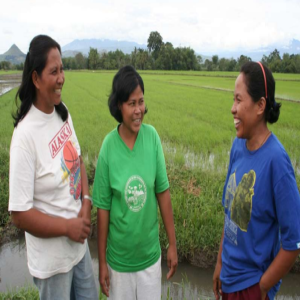 But because they had felt they weren’t being given the freedom and the funds to implement projects they were committed to doing, they decided to put up their own group in 1998. The Bukidnon Center for Sustainable Agriculture turned over farm equipment in 2001 and the women started various enterprises – farm equipment rental, food catering service and rice trading. At first, they bought and sold rice even if the suppliers were using conventional, inorganic methods. Membership exploded to more than a hundred but when MAKAKABUS enforced a “purely organic” policy, only eight women held on.
But because they had felt they weren’t being given the freedom and the funds to implement projects they were committed to doing, they decided to put up their own group in 1998. The Bukidnon Center for Sustainable Agriculture turned over farm equipment in 2001 and the women started various enterprises – farm equipment rental, food catering service and rice trading. At first, they bought and sold rice even if the suppliers were using conventional, inorganic methods. Membership exploded to more than a hundred but when MAKAKABUS enforced a “purely organic” policy, only eight women held on.
The move was necessary as one of MAKAKABUS’ objectives was to “implement sustainable / organic agriculture to alleviate poverty in Bukidnon province.” And since Valencia was being positioned as the organic rice capital of the Philippines, MAKAKABUS felt that it was in the best position to take advantage of increasing awareness of organic products. MAKAKABUS quickly realized, however, that it was up against human behavior, poverty and centuries of programming using unsustainable agriculture based on destructive practices inherited from the green revolution.
The move was necessary as one of MAKAKABUS’ objectives was to “implement sustainable /organic agriculture to alleviate poverty in Bukidnon province.” And since Valencia was being positioned as the organic rice capital of the Philippines, MAKAKABUS felt that it was in the best position to take advantage of increasing awareness of organic products. MAKAKABUS quickly realized, however, that it was up against human behavior, poverty and centuries of programming using unsustainable agriculture based on destructive practices inherited from the green revolution.
The women farmers, however, were not about to falter in their objective so they persevered. A production loan of Php 150,000 was acquired from PDAP and other NGOs, which was used to purchase palay.
One officer says, “There were members who quit because they could not commit to pure organic farming. They wanted three cropping cycles a year.”
While organic farming needs lesser farm inputs and is therefore, relatively less costly, small farmers still needed a fiancing scheme to support their decision to shift and continue sustaining their families.
The first year is particularly crucial because there is a slack in the harvest – two croppings instead of three are encouraged – to allow for a fallow period.
Daphne Frayco, MAKAKABUS’ Local Inspector, notes the early difficulties, “When we weren’t into organic farming yet, we could harvest up to 100 sacks but the costs were also expensive. When we went organic, we could only net up to 50 sacks.”
MAKAKABUS went through other painful growing pains, mainly problems with fiancing and also convincing the farmers to stay on the organic track. To encourage them to keep farming the organic way, MAKAKABUS presented itself as a market for the organic rice and become the right kind of middleman.
MAKAKABUS provided production loans to member-borrowers and bought their organic rice harvest at PhP 9 per kilo fild weight – 12.5 percent higher than the prevailing market price. The rice was processed using the group’s own post-harvest facilities because by then, MAKAKABUS had earned enough from farm equipment rental to buy more equipment.
Phasing into its new program, Promoting Rural Industries and Market Enhancement (PRIME), PDAP assisted MAKAKABUS in establishing an Internal Quality Control System (IQCS) to produce superior organic products.
Under PRIME, MAKAKABUS had developed another identity – as Local Market Consolidator (LMC) serving as intermediary between the market and farmers. This way, problems in the regularity of supply, high transaction cost, little bargaining power and transparency are addressed.
PDAP also guaranteed MAKAKABUS’ loans from MASS – SPECC of Php1 Million for trading capital and Php 4.5 Million for mortgaged land’s redemption project.
The farmers also knew that the profi margin is plowed directly to the organization. Every sack of palay merits 50 centavos for MAKAKABUS. So even if there are still ordinary rice traders that they can sell their produce to, farmers preferred MAKAKABUS. This trust made the organization what it is now.
In 2006, MAKAKABUS acquired an organic certifiate from the Organic Certifiation Center of the Philippines (OCCP) after it installed its IQCS. Then in the following year, it was able to buy commercial lot for its warehouse, solar dryer and rice mill exclusive for organic products MAKAKABUS also later found itself getting more land as because of poverty, many nonmembers were forced to mortgage their land to MAKAKABUS. Before acceptance, these farmers were screened and agreements were reached that the properties are to be used for organic production. An 80 to 20 percent sharing scheme was also forged providing the original owners the option to work their land while the organization provides training, inputs and helps manage the properties.
Some members who have mortgaged their lands to private individuals are assisted in the redemption and in the shifting to organic farming. The original owners gradually pay the mortgage until they are able to redeem the land from MAKAKABUS, preventing them from losing their properties.
The Land Acquisition and Management project has turned into the organization’s primary source of income with advocacy to non-organic believers as the value added in the scheme. In 2006, of the total 86 hectares devoted to organic farming, 20 hectares are mortgaged property. MAKAKABUS wants to bring the area of mortgaged property up to at least 25 hectares to fulfil its twin objectives of rescuing farmers from the tight grip of poverty and spreading the benefis of organic farming.
And MAKAKABUS is not about to stop growing, helping prove once again that women can lead, and lead well, indeed.
A TALE OF THREE PONDOHANS share
“SITANGKAI SEAWEEDS”
Located just 14 kilometers of the coast of Sabah, Malaysia, in the Philippines’ southernmost province of Tawitawi, is the municipality of Sitangkai, the country’s seaweed capital and the ‘Cottonii Seaweed Capital of the World’.
One of the 10 municipalities of Tawitawi, Sitangkai’s land mass consists of 12,750 hectares, a province of 307 islands and islets.
Sitangkai’s biggest island, Sibutu is host to a historical site of religious significance being the location of the burial site of Sheikh Makhdum, the Arab missionary who introduced Islam andbuilt the first mosque in the Philippines in the 9th century.
Its town proper, also called Sitangkai, is a bustling commercial center where many products from Malaysia and Indonesia are displayed and sold alongside the Philippines. Sitting on a strand that is barely one square kilometer in area, Sitangkai town proper is often called the “Venice of the Philippines” owing to its residential area and houses built on stilts and corrals with intricate canals and waterways reminiscent of Venice, Italy.
For centuries, the people of Sitangkai made a living from the rich marine ecosystem that surrounds the area. Situated in the Sulu-Sulawesi Seas, which account for 30% of the world’s coral reefs, fihing and harvesting of other marine products such as sea cucumber, sea urchin and sea mantis provide its people a major and stable source of income.
Eighty percent of its population, or about 20,000 individuals, rely on seaweeds for their living. Upon the advent of the seaweed industry in the area that began in the early 1950’s, many people from Sitangkai shifted to seaweed farming as their primary means of livelihood and income.
Seaweed cultivation in Sitangkai, Tawitawi is dominated by the ‘cottonii’ type because of the high demand in the market for kappa carrageenan which has diversifid applications.
The seaweed farmers of Sitangkai live in small villages-on-stilts called pondohans, which are constructed in shallow coral reef areas in the middle of the sea. Made of temporary and substandard construction materials like bamboo and nipa shingles, these pondohans are erected within the proximity of their seaweed farms to improve accessibility of the farmers to their farm sites and at the same time double as shelter and drying areas for harvested seaweeds.
Originally intended as half-way houses or places for stop-over, the pondohans are maintained by the seaweed farmers for as long as the seaweed thrives well in the area. It is not surprising therefore, to see pondohans that have been in existence for 30 or even 40 years.
On the average, a seaweed farmer maintains a farm size of one-fourth hectare that earns him or heran income of Php 21,800.00 annually. Fishing and harvesting of marine products serve as secondary or supplementary source of income for the family.
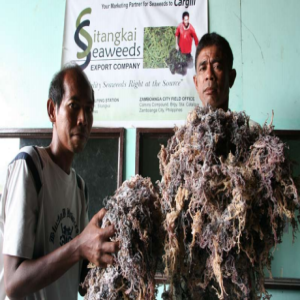 Of the over 100 existing pondohons which are home to over 10,000 seaweed farmers, Three have greatly benefitted from PDAP’s PRIME Program – Sipangkot, Sikulan, and Tinambak. These three pondohans were formalized into associations duly-recognized by the Department of Labor and Employment, been given capacity-building trainings, and provided with stilt driers. Two of the three sites now have seaweed nurseries.
Of the over 100 existing pondohons which are home to over 10,000 seaweed farmers, Three have greatly benefitted from PDAP’s PRIME Program – Sipangkot, Sikulan, and Tinambak. These three pondohans were formalized into associations duly-recognized by the Department of Labor and Employment, been given capacity-building trainings, and provided with stilt driers. Two of the three sites now have seaweed nurseries.
These pondohans have also benefied from PDAP initiatives to improve the plight of Sitangkai’s seaweed farmers such as access to export markets and constant price monitoring.
“PDAP’s intervention in the seaweeds industry is different from other PRIME commodities – muscovado sugar and organic rice – since it was PDAP-PRIME who initiated the formation of the seaweed farmers associations and the strengthening of the local seaweed industry,” Evangeline Faburada, PDAP project staff said.
Based on the baseline survey conducted by PDAP in 2006, the three sites have similar circumstances and challenges, which is somewhat reflective of all the pondohans in Sitangkai.
Most seaweed farmers earned less than Php 50,000.00 a year, with very few earning Php 100,000.00 and above. Household expenses were within Php 20,000.00 per year. Most farmers in the three sites cultivate seaweeds in just one parcel. To make both ends meet, most of the seaweed farmers raise poultry, are into fihing and aquaculture, and even participate in trading enterprises.
The high cost of production inputs, pests and diseases, limited access to better paying markets and lack of access to credit are the problems besetting the small seaweed farmers of Sitangkai.
“Seaweeds production involves many activities – clearing and posting, preparation of seedlings and planting materials, building a farm house, maintenance of planted seaweeds and harvesting and drying – which entail many costs. Many materials are also needed for maintenance and operation of the farm like mangrove posts, bamboo, pointed iron materials, bull hammers and banca,” MursidiArola, Sikulan Seaweed Farmers Association president, shares.
In 2006, the cost of producing seaweeds for one parcel ran to over Php 26,000.00, most of it was for the purchase of seedlings and planting materials, rental of boats and farm machinery, purchase of line, straws and flaters, and processing and drying fees.
Pest infestation, like the presence of seaweed-eating animals such as sea urchins, starfish and other predators were also major problems of seaweed farmers. Natural calamities and unfavorable weather conditions like strong currents or turbulent winds were also identified.
The farmers also lamented the high cost of hiring farm laborers. Normally, 2 to 5 men are needed for maintenance of a one-hectare seaweeds farm to clean the area and remove any dirt that clings to the seaweeds.
“In the past, farm labor was free because seaweed farming was a collective effort of the entire community. Now, people want to be paid either in cash or in kind for their efforts, maybe because of hard times or simply because people have become opportunistic,” Ibno J. Juaini, Sipangkot Seaweed Farmers Association president, laments.
Farmers also complained about the high cost of marketing, which is dictated by numerous factors such as convenience and distance from the farm to the buyer or trading stations, absence of infrastructure facilities such as farm-to-market roads and bridges, as well as the purchasing terms and other conditions set by the buyer.
“On the average, we spend almost Php 1,500.00 for marketing costs, which is basically the cost of transporting our produce to the traders or buying stations,” explains Almujir A. Abduraup, Tinambak Seaweed Farmers Association president.
Being the preferred buyers of most seaweed farmers for their produce, traders practically dictated the price of raw seaweed. It comes as no surprise therefore, that farmers often fell prey to unscrupulous traders.
While seaweed farmers are the bulwark of Sitangkai’s economy, it is sad to note that their living conditions remain poor. They still lack even the most basic needs like potable water, electricity, technology and telecommunications, even education.
Generally, a large portion of their household income is generally spent on food and the rest goes to other basic needs such as education, allowance, medical needs and clothing.
The entry of PDAP was via the crafting of the ‘SitangkaiSeaweeeds Master Plan’, with the Local Government Unit (LGU), other donors and concerned local stakeholders. Ocular visits, surveys and initial meetings with the core groups of identifid people’s organizations followed.
Formal organizing of communities, installation of stilt driers and nurseries, and the creation of the Sitangkai LMC (local market consolidator) Carageenan Corporation, were undertaken. The LGU was also assisted in crafting the seaweed master plan. Market access for the small seaweed farmers was facilitated initially through the Sitangkai Seaweeds Export Company (SITEXPORTS), which exports raw dried seaweeds to Cargill in France. The corporation is now in negotiations with the Chinese market and is ready to commence trading once the contract is secured.
Dramatically, the intervention of PDAP was able to at least improve the farm yield of farmers by 15percent. However, income-wise, the return is not signifiant due to unstable market demand and price fluctuations.
Thus, PDAP-PRIME employed the diversification approach to supplement the primary income source of farmers. The farmers were taught to culture abalone and glacilaria, a joint project between PDAP and the USAID-funded Grant for Equity in Mindanao (GEM) program.
The turning point for PDAP’s intervention was the provision of stilt driers and nurseries, which helped to increase volume and improve the quality of produce. The knowledge imparted to the farmers via a host of training programs improved farming technology, mitigated the effect of diseases and pests, and increased yield.
“Although these outcomes are part of our expectations when we began our interventions in Sitangkai, with the operationalization of SLMCC the results will be greatly optimized,” Jerry Pacturan, PDAP Executive Director, says.
For now, the three pondohans, like most of Sitangkai’s seaweed farming community, can hope of at least a fair chance of escape from the centuries-old cycle of poverty that have mired them. As Jolly Ahaja, CEO of SITEXPORT, PDAP-PRIME’s trading partner in Sitangkai, puts it,
“The fact that we have made headway in breaking the monopoly of trading in Sitangkai, and are slowly but surely operationalizing the Sitangkai LMC Corporation, is a good start.”


